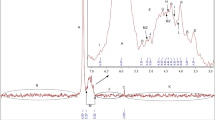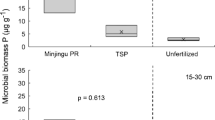Abstract
Purpose
Polyphosphate (poly-P) fertilizers were proposed to increase the low phosphorus use efficiency (PUE) of orthophosphate (ortho-P) fertilizer but empirical data is inconsistent. Our study is aimed at investigating how soil properties, application time, and growth duration affect their phyto-availability.
Methods
Olsen-P dynamics were monitored using six soils amended with either ortho-P or poly-P. Subsequently, two contrasting soils (sandy and loamy) were selected to estimate P availability to plants using wheat as a model plant. Mechanistic modelling was used to interpret P dynamics in these experiments.
Results
For poly-P amended soils, Olsen-P increased continuously, while using ortho-P fertilizer the highest values were attained right after application and then monotonously decreased afterward. Olsen-P dynamics varied greatly among soils depending on their sorption capacity and related properties. In sandy soils, Olsen-P was consistently higher for ortho-P. In highly calcareous soils, Olsen-P was higher for poly-P after three weeks. Plant experiments confirmed a greater uptake of poly-P over ortho-P in loamy soil and extended trials (4 months) but not in sandy soils or short-term trials (4 weeks). Geochemical modeling suggested that complexation of soil Ca by poly-P reduced long-term P immobilization.
Conclusions
Soil properties and growth duration affect the efficiency of ortho-P vs. poly-P fertilizers. In clayey soils and extended growth duration, poly-P fertilizer can enhance PUE due to its prolonged phyto-availability as compared to ortho-P. In sandy soils and short growth duration poly-P has little advantage. The complexation of Ca by poly-P may have caused the increase of P phyto-availability.








Similar content being viewed by others
Abbreviations
- P:
-
Phosphorus
- PUE:
-
P use efficiency
- Ortho-P:
-
Orthophosphate
- Poly-P:
-
Polyphosphate
- DW:
-
Distilled water
- SI:
-
Saturation index
References
Barrow N (2021) Comparing two theories about the nature of soil phosphate. Eur J Soil Sci 72:679–685
Barrow N, Shaw T (1976) Sodium bicarbonate as an extractant for soil phosphate III. Effects of the buffering capacity of a soil for phosphate. Geoderma 16:273–283
Chtouki M, Naciri R, Garré S, Nguyen F, Zeroual Y, Oukarroum A (2022) Phosphorus fertilizer form and application frequency affect soil P availability, chickpea yield, and P use efficiency under drip fertigation. J Plant Nutr Soil Sci 185(5):603–611
Conley DJ, Paerl HW, Howarth RW, Boesch DF, Seitzinger SP, Havens KE, Lancelot C, Likens GE (2009) Controlling eutrophication: nitrogen and phosphorus. Science 323:1014–1015
Dick R, Tabatabai M (1986) Hydrolysis of polyphosphates in soils. Soil Sci 142:132–140
Dick R, Tabatabai M (1987a) Factors affecting hydrolysis of polyphosphates in soils. Soil Sci 143:97–104
Dick RP, Tabatabai MA (1987b) Polyphosphates as sources of phosphorus for plants. Fertilizer Res 12:107–118. https://doi.org/10.1007/bf01048912
Engelstad O, Terman G (1980) Agronomic effectiveness of phosphate fertilizers. In: Khasawneh FE, Sample EC, Kamprath EJ (eds) The role of phosphorus in agriculture. ASA, Madison
Gao Y, Wang X, Shah JA, Chu G (2020) Polyphosphate fertilizers increased maize (Zea mays L.) P, Fe, Zn, and Mn uptake by decreasing P fixation and mobilizing microelements in calcareous soil. J Soils Sediments 20:1–11. https://doi.org/10.1007/s11368-019-02375-7
Gérard F (2016) Clay minerals, iron/aluminum oxides, and their contribution to phosphate sorption in soils—A myth revisited. Geoderma 262:213–226
Goh TB, Karamanos RE, Lee J (2013) Effects of phosphorus form on short-term solubility and availability in soils. Commun Soil Sci Plant Anal 44:136–144. https://doi.org/10.1080/00103624.2013.736162
Griffin B, Jurinak J (1973) Estimation of activity coefficients from the electrical conductivity of natural aquatic systems and soil extracts. Soil Sci 116:26–30
Gustafsson JP (2011) Visual MINTEQ 3.0 user guide. KTH, Department of Land and Water Recources, Stockholm, Sweden
Hamilton JG, Grosskleg J, Hilger D, Bradshaw K, Carlson T, Siciliano SD, Peak D (2018) Chemical speciation and fate of tripolyphosphate after application to a calcareous soil. Geochem Trans 19:1. https://doi.org/10.1186/s12932-017-0046-z
Hashimoto I, Lehr JR (1973) Mobility of polyphosphates in soil. Soil Sci Soc Am J 37:36–41. https://doi.org/10.2136/sssaj1973.03615995003700010016x
Henintsoa M, Becquer T, Rabeharisoa L, Gerard F (2017) Geochemical and microbial controls of the effect of citrate on phosphorus availability in a ferralsol. Geoderma 291:33–39
Hinsinger P (2001) Bioavailability of soil inorganic P in the rhizosphere as affected by root-induced chemical changes: a review. Plant Soil 237:173–195. https://doi.org/10.1023/A:1013351617532
Hinsinger P, Brauman A, Devau N, Gérard F, Jourdan C, Laclau J-P, Le Cadre E, Jaillard B, Plassard C (2011) Acquisition of phosphorus and other poorly mobile nutrients by roots. Where do plant nutrition models fail? Plant Soil 348:29–61
Hons F, Stewart W, Hossner L (1986) Factor interactions and their influence on hydrolysis of condensed phosphates in soils1. Soil Sci 141:408–416
Johnston AE, Poulton PR, Fixen PE, Curtin D (2014) Phosphorus: its efficient use in agriculture. Adv Agron 123:177–228
Khasawneh FE, Hashimoto I, Sample EC (1979) Reactions of ammonium ortho- and polyphosphate fertilizers in soil: II. Hydrolysis and reactions with soil. Soil Sci Soc Am J 43:52–58. https://doi.org/10.2136/sssaj1979.03615995004300010009x
Lin C, Negev I, Eshel G, Banin A (2008) In situ accumulation of copper, chromium, nickel, and zinc in soils used for long-term waste water reclamation. J Environ Qual 37:1477–1487
Lindsay WL, Vlek PL, Chien SH (1989) Phosphate minerals. Minerals Soil Environ 1:1089–1130
Liu L, Zheng X, Wei X, Kai Z, Xu Y (2021) Excessive application of chemical fertilizer and organophosphorus pesticides induced total phosphorus loss from planting causing surface water eutrophication. Sci Rep 11:23015. https://doi.org/10.1038/s41598-021-02521-7
Lombi E, McLaughlin MJ, Johnston C, Armstrong RD, Holloway RE (2004) Mobility and lability of phosphorus from granular and fluid monoammonium phosphate differs in a calcareous soil. Soil Sci Soc Am J 68:682–689. https://doi.org/10.2136/sssaj2004.6820
Lombi E, McLaughlin MJ, Johnston C, Armstrong RD, Holloway RE (2005) Mobility, solubility and lability of fluid and granular forms of P fertiliser in calcareous and non-calcareous soils under laboratory conditions. Plant Soil 269:25–34. https://doi.org/10.1007/s11104-004-0558-z
Lynch JP, Ho MD (2005) Rhizoeconomics: carbon costs of phosphorus acquisition. Plant Soil 269(1):45–56. https://doi.org/10.1007/s11104-004-1096-4
MacDonald GK, Bennett EM, Potter PA, Ramankutty N (2011) Agronomic phosphorus imbalances across the world’s croplands. Proc Natl Acad Sci 108:3086–3091
McBeath T, Lombi E, McLaughlin M, Buenemann E (2007a) Pyrophosphate and orthophosphate addition to soils: sorption, cation concentrations, and dissolved organic carbon. Soil Res 45:237–245
McBeath T, Lombi E, McLaughlin MJ, Bünemann EK (2007b) Polyphosphate speciation for soil and fertilizer analysis. Commun Soil Sci Plant Anal 38:2445–2460
McBeath T, McLaughlin MJ, Armstrong R, Bell M, Bolland M, Conyers M, Holloway R, Mason S (2007c) Predicting the response of wheat (Triticum aestivum L.) to liquid and granular phosphorus fertilisers in Australian soils. Soil Res 45:448–458
McBeath TM, Lombi E, Mclaughlin M (2004) Sorption of orthophosphate and pyrophosphate in Australian soils. 3rd Australian New Zealand Soils Conference
McBeath TM, Smernik RJ, Lombi E, McLaughlin MJ (2006) Hydrolysis of pyrophosphate in a highly calcareous soil. Soil Sci Soc Am J 70:856–862. https://doi.org/10.2136/sssaj2005.0184
McLaughlin MJ, McBeath TM, Smernik R, Stacey SP, Ajiboye B, Guppy C (2011) The chemical nature of P accumulation in agricultural soils—implications for fertiliser management and design: an Australian perspective. Plant Soil 349:69–87
Mehlich A (1984) Mehlich 3 soil test extractant: a modification of Mehlich 2 extractant. Commun Soil Sci Plant Anal 15:1409–1416
Montalvo D, Degryse F, McLaughlin MJ (2014) Fluid fertilizers improve phosphorus diffusion but not lability in Andisols and Oxisols. Soil Sci Soc Am J 78:214–224
Murphy J, Riley JP (1962) A modified single solution method for the determination of phosphate in natural waters. Anal Chim Acta 27:31–36
Nair PS, Logan TJ, Sharpley AN, Sommers LE, Tabatabai MA, Yuan TL (1984) Interlaboratory comparison of a standardized phosphorus adsorption procedure, vol 13, no 4. American Society of Agronomy, Crop Science Society of America, and Soil Science Society of America, pp 591–595
Olsen SR (1954) Estimation of available phosphorus in soils by extraction with sodium bicarbonate (No. 939). US Department of Agriculture
Ottman MJ, Thompson TL, Doerge TA (2006) Alfalfa Yield and Soil Phosphorus Increased with Topdressed Granular Compared with Fluid Phosphorus Fertilizer. Agron J 98. https://doi.org/10.2134/agronj2005.0257
Rulliere C, Perenes L, Senocq D, Dodi A, Marchesseau S (2012) Heat treatment effect on polyphosphate chain length in aqueous and calcium solutions. Food Chem 134:712–716. https://doi.org/10.1016/j.foodchem.2012.02.164
Simpson RJ, Oberson A, Culvenor RA, Ryan MH, Veneklaas EJ, Lambers H, Lynch JP, Ryan PR, Delhaize E, Smith FA (2011) Strategies and agronomic interventions to improve the phosphorus-use efficiency of farming systems. Plant Soil 349:89–120
Sparks DL, Page AL, Helmke PA, Loeppert RH (eds) (2020) Methods of soil analysis, part 3: chemical methods, vol 14. John Wiley & Sons
Subbarao Y, Ellis R (1975) Reaction products of polyphosphates and orthophosphates with soils and influence on uptake of phosphorus by plants. Soil Sci Soc Am J 39:1085–1088
Torres-Dorante LO, Claassen N, Steingrobe B, Olfs H-W (2005) Hydrolysis rates of inorganic polyphosphates in aqueous solution as well as in soils and effects on P availability. J Plant Nutr Soil Sci 168:352–358. https://doi.org/10.1002/jpln.200420494
Torres-Dorante LO, Claassen N, Steingrobe B, Olfs H-W (2006) Fertilizer-use efficiency of different inorganic polyphosphate sources: effects on soil P availability and plant P acquisition during early growth of corn. J Plant Nutr Soil Sci 169:509–515. https://doi.org/10.1002/jpln.200520584
Wang J, Chu G (2015) Phosphate fertilizer form and application strategy affect phosphorus mobility and transformation in a drip-irrigated calcareous soil. J Plant Nutr Soil Sci 178:914–922
Wang X, Gao Y, Hu B, Chu G (2019) Comparison of the hydrolysis characteristics of three polyphosphates and their effects on soil phosphorus and micronutrient availability. Soil Use Manag 35(4):664–674
Weeks JJ, Hettiarachchi GM (2019) A review of the latest in phosphorus fertilizer technology: possibilities and pragmatism. J Environ Qual 48:1300–1313
Weeks JJ, Hettiarachchi GM (2020a) Source and formulation matter: new insights into phosphorus fertilizer fate and transport in mildly calcareous soils. Soil Sci Soc Am J n/a. https://doi.org/10.1002/saj2.20054
Weeks JJ Jr, Hettiarachchi GM (2020b) Source and formulation matter: new insights into phosphorus fertilizer fate and transport in mildly calcareous soils. Soil Sci Soc Am J 84:731–746
Zhu J, Li M, Whelan M (2018) Phosphorus activators contribute to legacy phosphorus availability in agricultural soils: a review. Sci Total Environ 612:522–537. https://doi.org/10.1016/j.scitotenv.2017.08.095
Acknowledgements
This study was supported by the CFPN fund (Center of Fertilization and Plant Nutrition, grant number ICLF_2016.3). We thank Yonatan Weizman for excellent technical assistance in the greenhouse and the lab and to Dr. Pinchas Fine and Dr. Moshe Halperin for helpful suggestions and manuscript revision.
Funding
This study was supported by the CFPN fund (Center of Fertilization and Plant Nutrition, grant number ICLF_2016.3).
Author information
Authors and Affiliations
Corresponding author
Ethics declarations
Competing interests
The authors have no relevant financial or non-financial interests to disclose.
Additional information
Responsible Editor: Timothy Ian McLaren.
Publisher's note
Springer Nature remains neutral with regard to jurisdictional claims in published maps and institutional affiliations.
Supplementary Information
Below is the link to the electronic supplementary material.
Rights and permissions
Springer Nature or its licensor (e.g. a society or other partner) holds exclusive rights to this article under a publishing agreement with the author(s) or other rightsholder(s); author self-archiving of the accepted manuscript version of this article is solely governed by the terms of such publishing agreement and applicable law.
About this article
Cite this article
Erel, R., Yalin, D., Kushmaro-Bier, A. et al. Soil properties and growing duration determine phosphorus phyto-availability dynamics of polyphosphate versus orthophosphate fertilizers. Plant Soil 485, 299–315 (2023). https://doi.org/10.1007/s11104-022-05830-6
Received:
Accepted:
Published:
Issue Date:
DOI: https://doi.org/10.1007/s11104-022-05830-6




